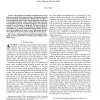Free Online Productivity Tools
i2Speak
i2Symbol
i2OCR
iTex2Img
iWeb2Print
iWeb2Shot
i2Type
iPdf2Split
iPdf2Merge
i2Bopomofo
i2Arabic
i2Style
i2Image
i2PDF
iLatex2Rtf
Sci2ools
TIT
2002
2002
Writing sequences on the plane
The problem of arranging two-dimensional arrays of data into one-dimensional sequences comes up in image processing, color quantization, and optical and magnetic data recording. A good arrangement should enable the one-dimensional sequences to be modeled as Markov chains or shifts of finite type. Since this is not possible in general, two-dimensional data is most commonly scanned by rows, columns, or diagonals. We look into three unusual ways to write a sequence in the plane: by Penrose tilings, by space-filling curves, and by cylindrical and spiral lattices. We show how Penrose tilings can be used to record information and how some spiral lattices can be used for quantization of color spaces.
| Added | 23 Dec 2010 |
| Updated | 23 Dec 2010 |
| Type | Journal |
| Year | 2002 |
| Where | TIT |
| Authors | Emina Soljanin |
Comments (0)

